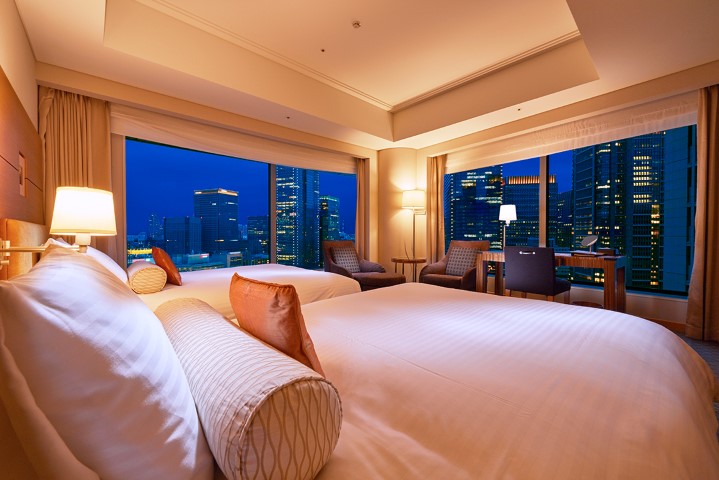Are you planning a holiday in Japan during February? Don’t Miss taking part in the experience of the Setsubun Festival in Japan also known as the Bean throwing festival. People really do throw beans!

Photo Credit: Setsubun. Licensed under CC BY-SA 3.0 via Commons
In Japan, Setsubun is celebrated the day before the official beginning of spring season. The chilly temperatures in February may not feel like Spring but it truly is the start of the season. Setsuban in Japanese means “seasonal division”, but it generally refers to the spring.
Sesuban is a time for spiritual spring cleaning. During mamemaki (the most famous ritual) people throw soybeans out the door to toss out bad luck and bring good fortune into the home. While doing so they shout ‘Oni wa soto! Fuku wa uchi!’ (Demons out! Good luck in!).
You can enjoy this ritual at Buddhist temples and Shinto shrines around Tokyo. Interestingly, most Japanese people practice both religions, and see no problem with that.
Pick up beans at the temples or shrines to receive good fortune. After the bean tossing you can participate in the custom of eating a makizuch roll while you face this year’s lucky direction.
When is the Setsubun Festival in Japan?
The Bean Festival in Tokyo is celebrated annually on February 3rd.
Where Can You Enjoy the Setusbun Festival in Tokyo?
At the major temples in Tokyo.
Japanese celebrities, including sumo wrestlers participate in mamemaki, a ritual to cleanse away the evil of the former year and drive away disease-bringing evil spirits for the year to come.
Recommended Tours to take at Setusbun Festival in Tokyo
Day Tour 1 in Tokyo: Best of Tokyo
Day Tour 2 in Tokyo: Highlights
Day Tour 1 in Kyoto: The Best of Kyoto
Day Tour 2 in Kyoto: Cherry Blossoms, Shrines and Geisha
Nara Day tour
Nikko Day tour
Hakone Day tour
Kamakura and Yokohama Day tour
Sensoji Temple, Asakusa
This is where the bean throwing started. It was the first temple in Japan to have a Setsubun ceremony. Be prepared for a crowd, because around 10,000 people come to watch the celebrities throw handfuls of soybeans. Starts at 2pm.
Getting There: Asakusa Station (Ginza, Asakusa, Tobu Isesaki lines)
Kongoji Temple, Hino
At Kongoji Temple, located in the suburbs of western Tokyo, it’s a pretty common experience to find Hello Kitty throwing beans. At the Kongoji Temple celebrations you won’t hear them shout shout ‘oni wa soto’, because they believe only righteous people would dare enter this temple. It’s all about good fortune here. Bean throwing at 10am, 11am, 1pm, 3pm and 4pm
Getting There: Takahatafudo Station (Keio line, Tama Toshi Monorail)
Honmonji Temple, Ikegami
At Honmonji you can expect to find the pro Sumo wrestler celebrities as the focus of the Festival. Activities start at 1pm. Bean throwing ceremony doesn’t start until 3pm
Getting There: Ikegami Station (Tokyu Ikegami line)
Zojoji Temple, Shiba Koen
Zojoji is known for being one of the lighter and more fun Setsubun festivals in Tokyo. Zojoji Temple’s ritual includes local kindergarteners in home-made costume, and then the tots and demons have their own Q&A session. Activities start at 11:45pm. Bean throwing ceremony starts at 12:30pm
Getting There: Shi ba-Koen Station (Mita line) or Daimon Station (Asakusa, Oedo lines)
Suitengu Shrine, Ningyocho
Suitengu is one of the few temples that makes you pay to participate in the bean throwing. It is ¥3,000 for adults and ¥2,000 for children. The ceremonies include beautiful performances of traditional kagura dancing and live music. Activities start at 3:00pm. Bean throwing ceremony starts at 3.15pm & 4.45pm
Getting There: Suitengumae Station (Hanzomon line) or Ningyocho Station (Hibiya, Asakusa lines)
Tokyo Tower, Shiba Koen
You’ll enjoy one of the most bizarre spectacles on the 150m observatory deck, which is Tokyo’s own version of the Eiffel Tower. A priest from the neighboring Zozoji Temple joins the Tokyo tower’s cone-headed Noppon mascots for some traditional bean-throwing. Activities start at 10.45am. Bean throwing ceremony starts at 3.15pm & 4.45pm
Getting There: Suitengumae Station (Hanzomon line) or Ningyocho Station (Hibiya, Asakusa lines)
History
Setsubun Festival in Japan is associated with the Spring, and seen as a sort of New Year’s Eve, and so was accompanied by a ritual to cleanse away the evil of the former year and drive away disease-bringing evil spirits for the year to come. This special ritual is called mamemaki.
Around the 13th century it became a custom to drive away the evil spirits using the smoke of burning wood, the smell of burning sardine heads, and the noise of drums. While this custom is no longer practiced, a few people still decorate the entrance to their homes with fish heads and holy tree leaves to deter the evil spirits from entering their homes.
In modern days, the tradition has become to throw roasted beans around one’s house and at the temples and shrines, while shouting “Oni wa soto! Fuku wa uchi!” (“Devils out, happiness in”). This is followed by picking up the number of beans equal to your age and then eating them.
Continue Reading:
More Tokyo Events
More Exciting Tokyo Things to do
Return from Setsubun in Japan to Tokyo Attractions





